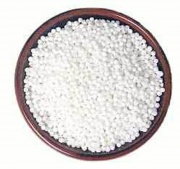Difference between revisions of "Tapioca starch"
| Line 7: | Line 7: | ||
''Manihot esculenta; Manihot duleis''; Tapioka (Deut.); almidón de tapioca (Esp.); amidon de tapioca (Fr.); amido di tapioca (It); cassava; manioc; Brazilian arrowroot | ''Manihot esculenta; Manihot duleis''; Tapioka (Deut.); almidón de tapioca (Esp.); amidon de tapioca (Fr.); amido di tapioca (It); cassava; manioc; Brazilian arrowroot | ||
| + | |||
| + | == Risks == | ||
| + | |||
| + | * Susceptible to biodeterioration. | ||
| + | * Dried films become brittle with age. | ||
== Physical and Chemical Properties == | == Physical and Chemical Properties == | ||
| Line 15: | Line 20: | ||
* Reacts with a iodine/potassium iodide solution to give a positive purple color | * Reacts with a iodine/potassium iodide solution to give a positive purple color | ||
| − | == | + | ==Resources and Citations== |
| − | |||
| − | |||
| − | |||
| − | |||
| − | |||
* G.S.Brady, ''Materials Handbook'', McGraw-Hill Book Co., New York, 1971 Comment: p. 766 | * G.S.Brady, ''Materials Handbook'', McGraw-Hill Book Co., New York, 1971 Comment: p. 766 | ||
Latest revision as of 08:12, 8 June 2022
Description
A beady Starch obtained from the tuberous roots of the cassava plant, Manihot esculenta and Manihot duleis, native to tropical America. The roots are leached then dried and ground. Cassava, or tapioca, starch has irregularly shaped kernels. It is composed of 20% amylose. Tapioca starch is the predominant starch used in Latin America. When heated with water, tapioca forms a thick stringy solution that gets thinner with heating time. It thickens only slightly on cooling to forms a translucent Gel. Tapioca is used for laundry starch, cooking, and as an Adhesive for stamps, envelopes, labels, and Plywood.
Synonyms and Related Terms
Manihot esculenta; Manihot duleis; Tapioka (Deut.); almidón de tapioca (Esp.); amidon de tapioca (Fr.); amido di tapioca (It); cassava; manioc; Brazilian arrowroot
Risks
- Susceptible to biodeterioration.
- Dried films become brittle with age.
Physical and Chemical Properties
- Small, oval granules with centrally located dark mark (hilum).
- Granule size = 5 - 35 micrometers.
- Gelatinization temperature = 49 - 70 C
- Reacts with a iodine/potassium iodide solution to give a positive purple color
Resources and Citations
- G.S.Brady, Materials Handbook, McGraw-Hill Book Co., New York, 1971 Comment: p. 766
- Reed Kay, The Painter's Guide To Studio Methods and Materials, Prentice-Hall, Inc., Englewood Cliffs, NJ, 1983
- Richard S. Lewis, Hawley's Condensed Chemical Dictionary, Van Nostrand Reinhold, New York, 10th ed., 1993
- Rosalie Rosso King, Textile Identification, Conservation, and Preservation, Noyes Publications, Park Ridge, NJ, 1985
- Encyclopedia Britannica, http://www.britannica.com Comment: "tapioca" [Accessed 28 Sept. 2005].
- Wikipedia: http://en.wikipedia.org/wiki/Tapioca (Accessed Sept. 28, 2005)
- Random House, Webster's Encyclopedic Unabridged Dictionary of the English Language, Grammercy Book, New York, 1997
- The American Heritage Dictionary or Encarta, via Microsoft Bookshelf 98, Microsoft Corp., 1998
